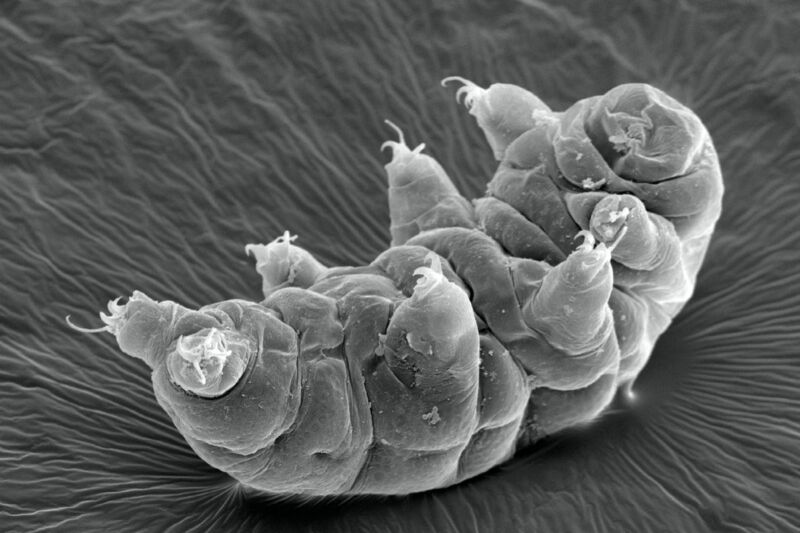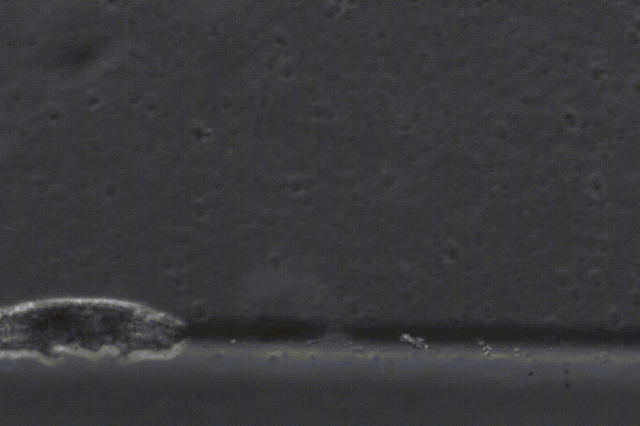
Is there nothing the tiny tardigrade can't do? More commonly known as water bears (or "moss piglets"), these amazing micro-animals can survive in the harshest conditions: extreme pressure, extreme temperature, radiation, dehydration, starvation—even exposure in outer space. That hardiness makes them a favorite case study for scientists.
Earlier this year, researchers at Rockefeller University examined the water bear's distinctive gait and concluded the creature's movement resembles that of insects 500,000 times their size, according to a paper published in August in the Proceedings of the National Academy of Sciences.
A more recent preprint published this month on the physics arXiv claims—controversially, it must be said—that frozen tardigrades can achieve a state of "temporary quantum entanglement" when incorporated into a superconducting qubit (quantum computing's basic unit of information), and then be revived again. If the findings hold up after peer review, it would be the first time any living animal has achieved a quantum entangled state.
"Slow walkers"
The "water bear" moniker comes to us courtesy of German zoologist Johann August Ephraim Goeze, who first observed the creatures in 1773 and named them kleiner Wasserbär ("little water bear"). An Italian biologist named Lazzaro Spallanzani dubbed the creatures tardigrades in 1777, from the Latin Tardigradum ("slow walker").
Both monikers were inspired by the creature's slow, lumbering gait, as well as their odd barrel-shaped bodies with four pairs of stubby legs. Most micro-animals the size of tardigrades (which are only about 0.02 inches long) don't even have legs, hence the Rockefeller team's interesting studying their movements further.
“Tardigrades have a robust and clear way of moving—they’re not these clumsy things stumbling around in the desert or in leaf litter,” said Jasmine Nirody, of Rockefeller’s Center for Studies in Physics and Biology, a co-author on the PNAS paper. “The similarities between their locomotive strategy and that of much larger insects and arthropods opens up several very interesting evolutionary questions.”
Ergo, "Tardigrades are an important porthole into soft-bodied, microscale locomotion," she said, with the potential to offer insight into how to build more efficient soft microscale robots. "We don’t know much about what happens at the extremes of locomotion—how to make an efficient small walker, or how soft-bodied things should move."
Initially, Nirody et al. placed the water bears on glass slides, but the slides were so slick, the tardigrades couldn't propel themselves along the surface very efficiently. They needed to be able to dig into a surface and push off with their claws. So the researchers replaced the glass slides with gels. Then they set up microscopes and cameras in the lab to collect hours and hours of footage of the creatures' movements, all of which the team reviewed.

“If you watch tardigrades under a light microscope for long enough, you can capture a wide range of behavior,” said Nirody. “We didn’t force them to do anything. Sometimes they would be really chill and just want to stroll around the substrate. Other times, they’d see something they like and run towards it.”
When they were just strolling around, the water bears generally moved at a rate of about half a body length per second, increasing to two body lengths per second when they loped at full throttle. The team was surprised to note that the water bears did not have distinct gaits for each speed, like horses as they transition from a walk to a gallop. Rather, their locomotion closely resembled that of insects and arthropods, scurrying along faster and faster with no change to the basic step pattern.
Specifically, as the tardigrades sped up, they would transition between having five legs on the ground, then four legs on the ground, then three legs on the ground—just like insects and arthropods, despite a 20-million-year evolutionary gap between them. "What that means is that despite having completely different body structures, body sizes, and environments that they're moving through, there's something about this particular coordination scheme that's efficient across all of these conditions," Nirody told Live Science.
There are two leading hypotheses for why this might be the case. Perhaps water bears, insects and arthropods share common ancestors that had a common neural circuit. Alternatively, the organisms may have evolved this scurrying gait independently through natural selection.
“If there is some ancestral neural system that controls all of panarthropod walking, we have a lot to learn,” said Nirody. “On the other hand, if arthropods and tardigrades converged upon this strategy independently, then there’s much to be said about what makes this strategy so palatable for species in different environments.”
Schroedinger's tardigrade?
The biomechanics are intriguing, but tardigrades may also be capable of unique quantum feats when in their hibernating (tun) state, according to quantum physicist Vlatko Vedral of the University of Oxford, one of the co-authors on the recent arXiv preprint. Entanglement is one of the strangest aspects of quantum mechanics, whereby two subatomic particles can be so closely connected that one can seem to influence the other even across long distances. It was so counter-intuitive that Albert Einstein famously dubbed it “spooky action at a distance.”
Quantum entanglement is nonetheless a very real phenomenon; without it, quantum computers would be impossible. In fact, as we reported in 2019, physicists successfully entangled a record-breaking 20 qubits to achieve a version of Schroedinger's cat in the lab.
While it's typically observed at the subatomic level, a 2018 study found that certain photosynthetic bacterial could become entangled with light photons under just the right circumstances. (Per Live Science, those conditions arise "when the resonant frequency of light in a mirrored room eventually synchronized with the frequency of electrons in the bacteria's photosynthetic molecules.")
But entanglement has never been achieved with a multi-cellular organism. Verdal et al. collected three tardigrades from a roof gutter in Denmark, and then froze them until they went into their tun state—shrinking to about a third of their normal size in the process. Then the team cooled the tardigrades down even further, to just above absolute zero.

Next they placed each tardigrade between two capacitor plates of a superconducting circuit (forming a qubit). The qubit's resonant frequency shifted every so slightly when it came into contact with a frozen tardigrade, forming a qubit-tardigrade hybrid. Finally, Verdal and his colleagues coupled that hybrid to a second qubit and entangled them. Several tests on the entangled qubits showed a shift in frequency occurring simultaneously between both qubits and the tardigrade—much like three entangled qubits. The team was even able to revive the tardigrades after the experiments concluded.
"While one might expect similar physical results from inanimate objects with similar composition to the tardigrade, we emphasize that entanglement is observed with [an] entire organism that retains its biological functionality post experiment," Vedral et al. concluded. "At the same time, the tardigrade survived the most extreme and prolonged conditions it has ever been exposed to."
We aren't likely to see quantum computers running on entangled tardigrades any time soon, however. Verdal et al.'s conclusion was met with immediate skepticism from other physicists. For instance, former physicist turned science writer Ben Bruabker posted a lengthy Twitter thread calling the findings into question, while Rice University physicist Douglas Natelson weighed in on his blog, Nanoscale Views:
This is not entanglement in any meaningful sense. If it were, you could say by the same reasoning that the qubits are entangled with the macroscopic silicon chip substrate. The tardigrade does not act as a single quantum object with a small number of degrees of freedom. The dynamics of the tardigrade's internal degrees of freedom do not act to effectively decohere the qubit (which is what happens when a qubit is entangled with many dynamical degrees of freedom that are then traced over).
Verdal defended his team's controversial claim in a recent FQXI podcast.
DOI: PNAS, 2021. 10.1073/pnas.2107289118 (About DOIs).
reader comments
84